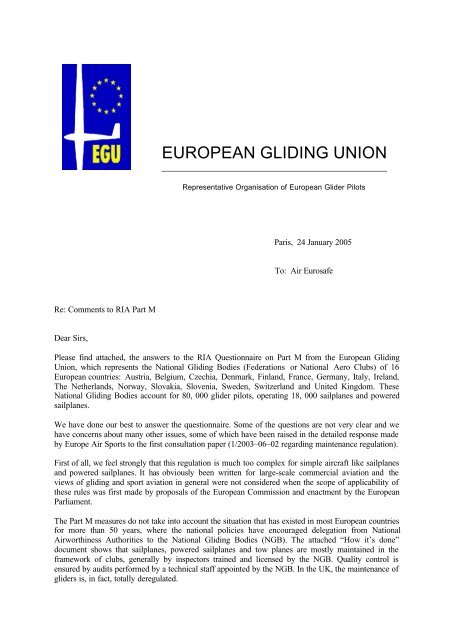Cover Letter to the EGU answer - European Gliding Union
Cover Letter to the EGU answer - European Gliding Union
Cover Letter to the EGU answer - European Gliding Union
Create successful ePaper yourself
Turn your PDF publications into a flip-book with our unique Google optimized e-Paper software.
Re: Comments <strong>to</strong> RIA Part M<br />
Dear Sirs,<br />
EUROPEAN GLIDING UNION<br />
___________________________________________________________<br />
Representative Organisation of <strong>European</strong> Glider Pilots<br />
Paris, 24 January 2005<br />
To: Air Eurosafe<br />
Please find attached, <strong>the</strong> <strong>answer</strong>s <strong>to</strong> <strong>the</strong> RIA Questionnaire on Part M from <strong>the</strong> <strong>European</strong> <strong>Gliding</strong><br />
<strong>Union</strong>, which represents <strong>the</strong> National <strong>Gliding</strong> Bodies (Federations or National Aero Clubs) of 16<br />
<strong>European</strong> countries: Austria, Belgium, Czechia, Denmark, Finland, France, Germany, Italy, Ireland,<br />
The Ne<strong>the</strong>rlands, Norway, Slovakia, Slovenia, Sweden, Switzerland and United Kingdom. These<br />
National <strong>Gliding</strong> Bodies account for 80, 000 glider pilots, operating 18, 000 sailplanes and powered<br />
sailplanes.<br />
We have done our best <strong>to</strong> <strong>answer</strong> <strong>the</strong> questionnaire. Some of <strong>the</strong> questions are not very clear and we<br />
have concerns about many o<strong>the</strong>r issues, some of which have been raised in <strong>the</strong> detailed response made<br />
by Europe Air Sports <strong>to</strong> <strong>the</strong> first consultation paper (1/2003–06–02 regarding maintenance regulation).<br />
First of all, we feel strongly that this regulation is much <strong>to</strong>o complex for simple aircraft like sailplanes<br />
and powered sailplanes. It has obviously been written for large-scale commercial aviation and <strong>the</strong><br />
views of gliding and sport aviation in general were not considered when <strong>the</strong> scope of applicability of<br />
<strong>the</strong>se rules was first made by proposals of <strong>the</strong> <strong>European</strong> Commission and enactment by <strong>the</strong> <strong>European</strong><br />
Parliament.<br />
The Part M measures do not take in<strong>to</strong> account <strong>the</strong> situation that has existed in most <strong>European</strong> countries<br />
for more than 50 years, where <strong>the</strong> national policies have encouraged delegation from National<br />
Airworthiness Authorities <strong>to</strong> <strong>the</strong> National <strong>Gliding</strong> Bodies (NGB). The attached “How it’s done”<br />
document shows that sailplanes, powered sailplanes and <strong>to</strong>w planes are mostly maintained in <strong>the</strong><br />
framework of clubs, generally by inspec<strong>to</strong>rs trained and licensed by <strong>the</strong> NGB. Quality control is<br />
ensured by audits performed by a technical staff appointed by <strong>the</strong> NGB. In <strong>the</strong> UK, <strong>the</strong> maintenance of<br />
gliders is, in fact, <strong>to</strong>tally deregulated.
NAA scrutiny has invariably found that NGBs are fully capable of ensuring air safety, as demonstrated<br />
by accident/incident rates which compare favourably with, and often exceed, those where stricter<br />
legislation is applied.<br />
Additionally, <strong>the</strong>se maintenance procedures, which are mainly based on voluntary work, are cost<br />
effective, and administratively not <strong>to</strong>o burdensome.<br />
The implementation of <strong>the</strong> current Part M <strong>to</strong> gliding would oblige all existing organisations <strong>to</strong> apply <strong>to</strong><br />
become Subpart F or G organisations. This would clearly lead <strong>to</strong> a huge increase of <strong>the</strong> bureaucratic<br />
workload of <strong>the</strong> voluntary staff in air sports organisations without achieving safety gains.<br />
Fur<strong>the</strong>rmore, <strong>the</strong> existing Part M relies on <strong>the</strong> availability of Part 66 licensed staff for issuing various<br />
certificates. Since <strong>the</strong>re are very few people in gliding licensed <strong>to</strong> such a high level, <strong>the</strong> gliding<br />
organisations would have <strong>to</strong> recruit Part 66 licensed engineers. Even if <strong>the</strong> associated costs are very<br />
difficult <strong>to</strong> estimate at <strong>the</strong> present stage, it is obvious that this would make sailplane maintenance<br />
dramatically more expensive.<br />
We would remind you that <strong>the</strong> financial aspects are particularly important for air sports because leisure<br />
pilots pay <strong>the</strong>ir own flying costs and any rule that increases <strong>the</strong> costs will result in pilots flying less<br />
(which will, in fact, have an adverse effect on safety) or giving up flying (which will be detrimental <strong>to</strong><br />
our sport and <strong>to</strong> personal freedom and choice and limit <strong>the</strong> social groups who can afford our activity).<br />
For all <strong>the</strong>se reasons, <strong>the</strong> current Part M is clearly unacceptable for <strong>the</strong> <strong>European</strong> <strong>Gliding</strong> movement.<br />
As <strong>the</strong>re is obviously no safety case, <strong>the</strong> <strong>EGU</strong> requires this regulation <strong>to</strong> be thoroughly modified in<br />
order <strong>to</strong> allow <strong>the</strong> maintenance of sailplanes and powered sailplanes <strong>to</strong> be done in a much more<br />
pragmatic and cost effective way. In our opinion, this can only be achieved by taking in<strong>to</strong> account <strong>the</strong><br />
existing solutions which have proven <strong>to</strong> work satisfac<strong>to</strong>rily for many years.<br />
As already mentioned in <strong>the</strong> past, we are willing <strong>to</strong> assist <strong>the</strong> bodies/rulemakers involved by offering<br />
our expertise and experience <strong>to</strong>wards working out a solution satisfac<strong>to</strong>ry <strong>to</strong> all parties.<br />
Yours sincerely,<br />
Roland Stuck<br />
<strong>EGU</strong> President





